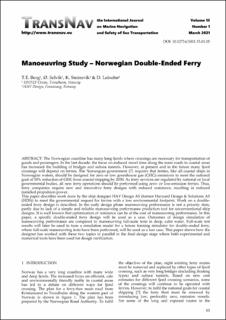| dc.contributor.author | Berg, Tor Einar | |
| dc.contributor.author | Selvik, Ørjan | |
| dc.contributor.author | Steinsvik, Kristian | |
| dc.contributor.author | Leinebø, Daniel | |
| dc.date.accessioned | 2022-10-12T12:21:59Z | |
| dc.date.available | 2022-10-12T12:21:59Z | |
| dc.date.created | 2021-06-15T12:59:26Z | |
| dc.date.issued | 2021 | |
| dc.identifier.issn | 2083-6473 | |
| dc.identifier.uri | https://hdl.handle.net/11250/3025610 | |
| dc.description.abstract | The Norwegian coastline has many long fjords where crossings are necessary for transportation of goods and passengers. In the last decade, the focus on reduced travel time along the main roads in coastal areas has increased the building of bridges and subsea tunnels. However, at present and in the future many fjord crossings will depend on ferries. The Norwegian government [7] requires that ferries, like all coastal ships in Norwegian waters, should be designed for zero or low greenhouse gas (GHG) emissions to meet the national goal of 50% reduction of GHG from coastal shipping by 2030. As ferry services are regulated by national or local governmental bodies, all new ferry operations should be performed using zero- or low-emission ferries. Thus, ferry companies require new and innovative ferry designs with reduced resistance, resulting in reduced installed propulsion power. This paper describes work done by the ship designer HAV Design AS (former Havyard Design & Solutions AS (HDS)) to meet the governmental request for ferries with a low environmental footprint. Work on a double-ended ferry design is described. In the early design phase manoeuvring performance is not a priority item, partly due to lack of a simple and reliable manoeuvring performance prediction tool for unconventional ship designs. It is well known that optimization of resistance can be at the cost of manoeuvring performance. In this paper, a specific double-ended ferry design will be used as a case. Outcomes of design simulation of manoeuvring performance are compared to manoeuvring full-scale tests in deep, calm water. Full-scale test results will later be used to tune a simulation model for a future training simulator for double-ended ferry, where full-scale manoeuvring tests have been performed, will be used as a test case. This paper shows how the designer has worked with these two topics in parallel in the final design stage where both experimental and numerical tools have been used for design verification. | en_US |
| dc.language.iso | eng | en_US |
| dc.publisher | TransNav | en_US |
| dc.rights | Navngivelse 4.0 Internasjonal | * |
| dc.rights.uri | http://creativecommons.org/licenses/by/4.0/deed.no | * |
| dc.title | Manoeuvring Study – Norwegian Double-Ended Ferry | en_US |
| dc.type | Peer reviewed | en_US |
| dc.type | Journal article | en_US |
| dc.description.version | publishedVersion | en_US |
| dc.rights.holder | The Transnav - International Journal on Marine Navigation and Safety of Sea Transportation articles are distributed under the terms of the Creative Commons Attribution License (CC BY-NC), which permits unrestricted use, distribution, and reproduction in any medium, provided the original author and source are credited. For licence details please see http://creativecommons.org/licenses/by-nc/3.0/ | en_US |
| dc.source.volume | 15 | en_US |
| dc.source.journal | TransNav, International Journal on Marine Navigation and Safety of Sea Transportation | en_US |
| dc.source.issue | 1 | en_US |
| dc.identifier.doi | 10.12716/1001.15.01.05 | |
| dc.identifier.cristin | 1915897 | |
| cristin.ispublished | true | |
| cristin.fulltext | original | |
| cristin.qualitycode | 1 | |

